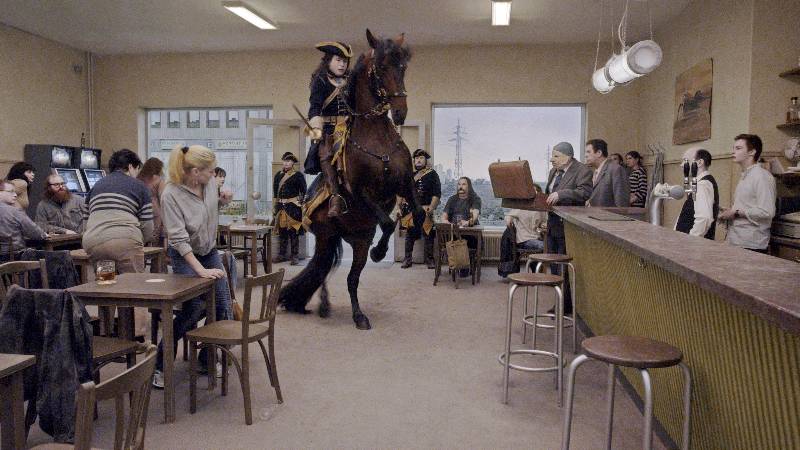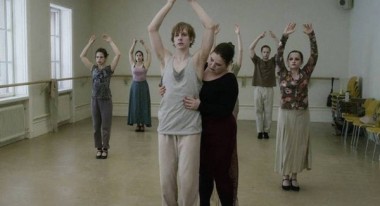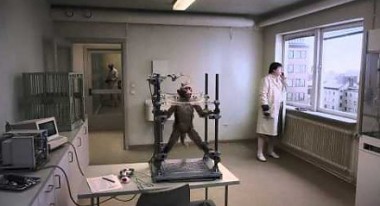 Back to selection
Back to selection
Cooed: A Pigeon Sat on a Branch Reflecting on Existence
 A Pigeon Sat on a Branch Reflecting on Existence
A Pigeon Sat on a Branch Reflecting on Existence Powerful imagination and credible spatiality are among the major absences in today’s cinema lamented by Swedish filmmaker Roy Andersson. A compensatory corrective is provided, of course, by his own films, including multiple award-winning commercials and the films in “The Living Trilogy”: Songs From the Second Floor (2000), You the Living (2007), and, just opening in the US, the marvelously wry A Pigeon Sat on a Branch Reflecting on Existence (2014).
The movies are assemblages of broad tableaus of relatively short duration, filmed with a static camera. The segments are like an inspired mix of tromp l’oeil, flattened Joseph Cornell boxes, and Gregory Crewdson photographs mimicking the production design of a solo movie shot. Plain and banal they are not, enriched and enlivened as they are by eye-catching, sharply defined, and obliquely positioned and framed subjects and objects. Here is his imagination at work: Andersson’s fertile fantasies trigger our own.
Space plays a significant part in defining characters, but he comes close to displacing it with the broad sweep of history, which acts like a third dimension. The minimal number of shots in his films (only 39 in the whole of A Pigeon Sat…) are neither necessarily chronological nor arranged within sequences subscribing to such arbitrary conventions as classical, post-Griffith editing. They leap backward and forward in time, for example, often sharing the exact same space in different years, or replicating earlier images. We get an irregular, often circuitous simulation of cause-and-effect that defies our sense of logic while at the same time functioning as an abridged reinterpretation of history’s complexities.
The connections are generally loose. Fixating on the isolated, immobile, gracefully pared-down wide shots assures a high degree of saturation in the process of perception. You have leisure to scan the mise-en-scene, pretty much exhausting visual or aural information contained in the shots, before you are sufficiently vulnerable to be exposed to those following. As you take in additional data over the course of the narrative, new perspectives emerge. The total becomes greater than the sum of the parts. It is a cinema of tiers.
The arrangement of this mélange partially explains how humor (much of it ironic, and tinged with the theme of death), tragedy, social critique, philosophy, and cultural anthropology coexist harmoniously and unforcedly, capturing life’s natural flow on celluloid (or, in the case of Pigeon, digitally).
Their relative weight is equivocal — essential for Andersson, a great humanist from working-class roots who prepares meticulously to create a democratic feel. He labored full-time for four years to make Pigeon. His commitment is ideological, far from the hegemony of economics which he so vociferously despises (especially in filmmaking), and to which he repeatedly assigns responsibility for social stratification, oppression, and regulation of individual rights. He stresses the dictatorship of order, laws, and language, with the purpose of containing chaos to the advantage of the ruling class. These are forms of humiliation, for him the basest of sins.
A typical synopsis fails to capture the convoluted plotlines, much less essence, of his work. My brain becomes foggy drawing a mental sketch of a pitch session in which financiers and moguls desperately attempt to follow his off-the-rails train of thought. The interlock is there, but it’s not readily apparent.
Without the overlying aesthetic that pulls it all together, a summary does not make a hell of a lot of sense. How do you verbalize the impact of an accordion-like depth of field, or lack of inflection as the norm in dialogue? Or scenes in which so little transpires that they resemble freeze frames? Let’s give it a try with some bits and pieces of zigzagging narrative that comprise A Pigeon Sat….
In Andersson’s hometown of Gothenburg, a Beckett-like pair of simpleminded, pasty travelling salesmen — Sam (Nils Westblom) and Jonathan (Holger Andersson), who specialize in limited, useless novelty items (the Uncle One-Tooth mask) — harass shop owners to obtain their commissions while themselves feeling pressure from manufacturers demanding a quick return of profits. The office of this ever-arguing pair (humiliation is part of their routine) is a dorm-like flophouse that makes up in strict rules what it lacks in charm. They are centerpieces: Their paths cross, almost by chance, those of assorted denizens of the city — individuals from current and past epochs in pubs, offices, parks. In and around the loosely configured scenes, the two unappealing, magnetism-challenged fellows keep reappearing, as much connective tissue as actual characters.

Some scenes, though, have nothing to do with them, as if coming out of nowhere: a woman rocking a baby carriage, a couple lying on the ground kissing, a man dying in a ship’s café (the captain reappears as a barber), various couples standing around their apartments doing essentially nothing, students studying in a flamenco class led by a lecherous older woman (the clomping of their dance shoes on the wooden floor is piercing), the interior of a fancy restaurant from the point-of-view of an unwelcome outsider at the window, a full classroom of preteen students going through a show-and-tell, an infectious musical number that takes us back to 1943 in a fully valorized, unpretentious pub where “Limping Lotta” (Charlotta Larsson) trades beers with lonely sailors for kisses, her club foot rising behind at the point of lip-to-lip impact.
The absurdism doesn’t stop there. In one long sequence, sadistic British colonialists seal African slaves inside a copper missile-shaped coffin and set it ablaze. A series of scenes that go back to the late-17th century and the reign of King Charles XII (Viktor Gyllenberg), on his way to and from war in Russia, also take place in contemporary times, and reduce him from legendary macho war hero to obsessed, fey young cruiser of a powerless bartender. None of the shots of, and references to, the titular pigeon has the gravitas that the name of the film would suggest. (The strongest, in a poem, diminishes the supposedly pensive bird to a money grubber.)
A Pigeon Sat… is darkly funny, in a Scandinavian, not-laugh-out-loud sort of way — and downright bizarre, like the scene of a howling monkey strapped to a support on an office desk while a woman chats on a phone behind it. (The assorted species depicted here, including by association homo sapiens, are all presented in unnatural contexts. It’s surreal; Andersson uses the term stylized realism.) As finely detailed as the individual shots are, the overall dis-order is what gives the film its unique, unpredictable rhythm. For this filmmaker, life is less an intangible concept than a collection of trivialities. An easily digested narrative, no, but the startling juxtapositions and enticing painterly compositions in this remarkably skewed movie are a source of joy from start to finish.
New York-based IFP members can get free tickets to a screening of Andersson’s Songs from the Fifth Floor this Friday, June 5 at the Museum of Arts and Design. Use the code “IFP” when purchasing tickets online here or over the phone.

